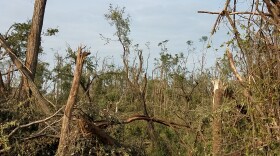The City of Cedar Rapids has released a far-reaching proposal that aims to significantly reduce the community’s greenhouse gas emissions in order to achieve net-zero carbon emissions by 2050. The draft Cedar Rapids Community Climate Action Plan, released at a public event Tuesday, is slated to go before the city council for consideration next week.
The Cedar Rapids Community Climate Action Plan envisions a carbon-free future where residents are not only helping stave off the worst impacts of global climate change, but are able to meet all their basic needs within a short, 15 minute walk of their front doors.
Living in energy efficient homes powered by clean energy, with ready access to green spaces reachable on foot or via low-emissions public transit, working in a community where business and industry run off of renewable, clean power, city officials see a future where carbon neutrality not only helps forestall the harshest impacts of climate change around the world, but makes life better, richer and more resilient at home in Iowa.
“Climate change is bringing heavier rainfalls, hotter days and more flooding across Iowa — and extreme weather to every corner of our world. Cedar Rapids is no exception. Our Community Climate Action Plan brings focus to these changing realities,” reads a message from Mayor Brad Hart and City Manager Jeff Pomeranz at the beginning of the plan.
“This plan also builds upon our community’s strengths,” the message continues. “Our Community Climate Action Plan charts a future rich in community, passion and dedication to the greater good.”
Under the plan, the city would reduce its carbon emissions 45 percent by 2030 and achieve net zero emissions by 2050, in line with targets aimed at keeping global temperature increases below 1.5 degrees Celsius.
The plan outlines a range of actions needed to reach those goals, ranging from improving home energy efficiency and promoting infill development in the city’s core neighborhoods to supporting large-scale solar power developments and investing in electric vehicle infrastructure.
The plan also hinges on major businesses and industries making significant strides in their own carbon reduction plans, such as rapidly transitioning to solar and wind energy sources. According to the document, more than 70 percent of the city’s emissions come from industrial processes.
Review the Community Climate Action Plan at our open house event on Tuesday. https://t.co/g2VaHv0qZF (1/4)
— City of Cedar Rapids (@CityofCRiowa) September 20, 2021
A key focus of the plan centers on promoting equity throughout the climate transition, with the document contemplating how efforts would impact the most vulnerable, taking into account socioeconomic status, educational attainment, minority status, transportation needs and disabilities, among other factors.
“As climate change intensifies, the basic needs of vulnerable residents in Cedar Rapids should be prioritized. Residents who have barriers to achieving basic needs experience daily stress, making them susceptible to greater challenges when faced with extreme weather,” the plan notes. “Prioritizing the needs of vulnerable residents in a planning process ensures their needs are central to the plan’s outcomes.”
Residents had the chance to review the plan and hear from members of the climate advisory committee that oversaw its development at a public house event Tuesday at the downtown public library.
The release of the plan follows months of deliberation and public engagement, including gathering feedback through public events, focus groups and surveys. According to the city, some of the top concerns residents identified in the surveys were extreme heat, renewable energy, tree replacement, energy efficient homes and healthy food access.
The plan drives home the risks that Cedar Rapids faces if decisive action isn’t taken; according to the document, the number of days over 90 degrees Fahrenheit are forecasted to triple by the mid to late 21st Century. Heavy rainfall is expected to increase the chances of flooding, with the Cedar River rising an inch per decade.
Pomeranz says the climate action plan will help residents, business and industry take steps to lessen the impacts of extreme weather events, which the city has seen its fair share of.
“Cedar Rapids has first-hand experience with the results of our changing climate. Our community has endured a disproportionate share of extreme climate events,” Pomeranz said in a written statement. “Major weather events like the Floods of 2008 and 2016, and the derecho in 2020 have come at significant cost and with many opportunities to learn, adapt and improve. Cedar Rapids’ Community Climate Action Plan will advance our work to mitigate climate change and adapt to its increasing consequences.”
The development of the plan came after the city council approved a climate action resolution in February of 2020, which called for zeroing out the city’s carbon emissions by mid-century, promoting community-wide sustainability efforts and ensuring access to basic needs for the city’s most vulnerable residents during the climate transition.
The climate action plan will not be considered final until it's been approved by the city council. The document will be presented to the council for possible adoption during its Sept. 28 meeting, when residents can share additional public comments. Council members can vote to approve the plan as soon as that day or opt for more discussion or revision.
Takeaways of the Community Climate Action Plan
- aims to reduce carbon emissions 45 percent by 2030 and 100 percent by 2050
- aims to guarantee access to clean water and air, healthy food, good parks & nature, good-paying green jobs, and direct connections to city government
- aims to encourage industries to reduce emissions through efforts like carbon capture and renewable energy
- estimates that 72 percent of Cedar Rapids’ greenhouse gas emissions come from industrial processes
- notes that the number of days over 90 degrees are forecasted to triple by the mid to late 21st Century





